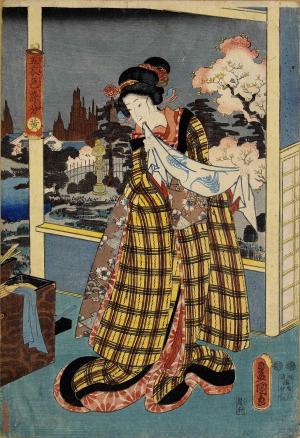The Five Fabric Colors: Yellow (Itsutsuginuiro no Somewake: Ki)
Painted by Utagawa Kunisada I 1851 (Kaei 4) Tokyo Shiryō Collection K1021-3-2
In this series each of the five colors used for dyeing fabric - blue, red, yellow, white, and black - is embodied in the figure of a beautiful woman. Chosen to represent "yellow" was O-koma, a character from the Jōruri puppet and Kabuki play Koimusume Mukashi Hachijō.
O-koma is dressed in a kihachijō kimono featuring stripes on a yellow base. Kihachijō is a silk fabric with the three keynote colors of yellow, tan, and black. Its name derives from the place of manufacture, Hachijō-jima in the Izu Islands. It was presented as tribute to the Shogun's household, and until the middle Edo period was only permitted to be worn by members of higher-ranked warrior households. Produced in 1775 (An'ei 4), the Jōruri play Koimusume Mukashi Hachijō was based on the true story of a liaison between a man named Chūshichi and a woman O-kuma, who wore a kihachijō kimono. This play was well received by Edo residents and the kihachijō kimono worn by its heroine, who was renamed O-koma in the play, enjoyed great popularity among young women.


